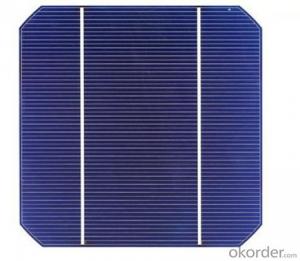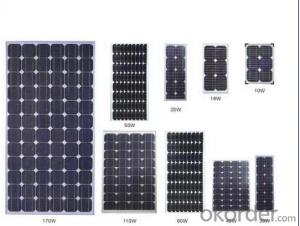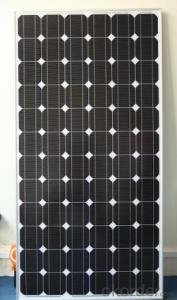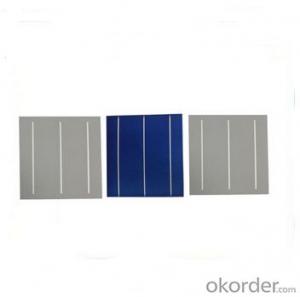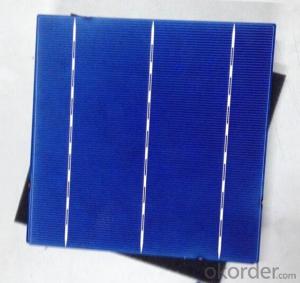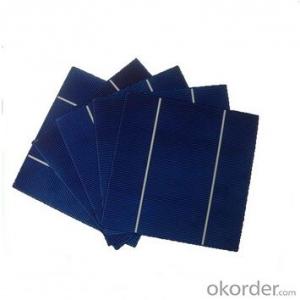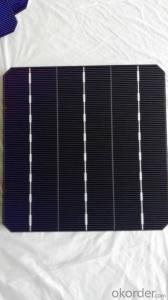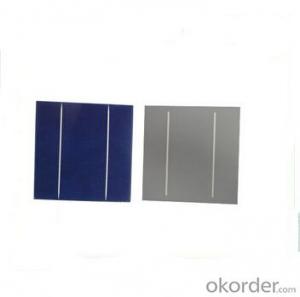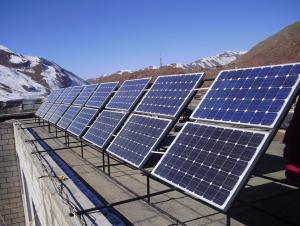Solar Cells in Glass - Poly-Crystalline Solar Cell 156mm with Excellent Conversion Efficiency and Weak Light Performance
- Loading Port:
- Tianjin
- Payment Terms:
- TT or LC
- Min Order Qty:
- 10 watt
- Supply Capability:
- 500 watt/month
OKorder Service Pledge
OKorder Financial Service
You Might Also Like
Guaranteed by refinement solar cell producing process, up to 18.1% efficiency for mass production of CSG-MM156 series cells, up to 18.5% for the highest efficiency, up to 265W (6×10 Series) for module output max power;
Better shortwave response ensured by Selective Emitter Technology;
Better continuousness of fingers and stable performance ensured by Double Printing Technology;
Whole-process inspection from wafer input to cell packaging, to ensure high quality and excellent performance;
Production and Quality Control
CSG fully integrated PV chain from silicon materials, ingot, wafer, solar cell to solar module, and well-established QC management system, to guarantee consistency of high quality;
Mature technical control and strict sorting standard, to ensure consistency and reliability of solar cell;
Completely careful operation during production to avoid micro-cracks and reduce breakage rates during module assembly;
Electrical Properties
Mature crystalline cells manufacturing technology and complete quality control system, to ensure excellent electrical stability;
Lower module encapsulation loss realized by reasonable electrical characteristics setting, including high voltage and low current, high parallel resistance and low series resistance, classification with precise current classes, and positive power tolerance;
Excellent conversion efficiency, weak light performance and shortwave response guaranteed by leading R&D innovation system;
Recommend Welding Technique
Welding:tin-coated copper ribbons, coated with 20-25μm thickness (64%Sn,36%Pb)
Applications of Solar Cell Products
1.Fields of Aerospace, Space development and Space-tech.
Solar cells products first to show their talents in space technology because of its reliability and unique superiority. 1958 Solar first landed on satellites. Thus aerospace, satellites have not been away from the solar cell; the development of future space, the first month of the solar cell kicking will play an important role. It landed on other planets, the current Mars rover "Spirit", "Opportunity" solar cells on which they work is the main power supply.
2. Application of industrial and agricultural production.
Solar cell products have also been widely used in the industrial and agricultural as a new energy. In scattershot interpersonal mountain sea, a variety of lighthouse beacon, a variety of satellite communication station; a variety of remote sensing, meteorological station, road and rail automatic lights have become the preferred power source.
In many remote areas without electricity-grid, photovoltaic power supply system is widely used too.
Photocell gets a lot of applications in automatic control, such as the measurements of seized and number for the plant products; production of various types of sensors; photocell various wavelengths (colors) in response to different sensitivity (or stamped filter) of the probe light color.
Solar cell products are also the professional solar power of Transportation, communications, forestry, agriculture, television, meteorology, geology and other.
3. Small civilian life products
Solar cell products have lots of small product range, under various names currently.
(1) Small-scale photovoltaic system class:
Solar charger: cases can give two AA nickel-cadmium battery, or do a small 3V power supply.
Solar Calculator: portable pocket calculator to do the power supply, there is light can work.
Solar hood: use a small fan to automatically adjust the sun, summer is cool to take the absolute best.
Solar portable lights: solar battery charging, energy storage batteries, particularly suitable for areas without electricity and mobile use.
(2) Many variety of electrical equipment and backup power.
- Q: Can solar cells be damaged by hail or other weather events?
- Yes, solar cells can be damaged by hail or other severe weather events. Hailstones can potentially crack or shatter the surface of the solar panels, affecting their efficiency and functionality. Similarly, extreme weather events like hurricanes or heavy storms can cause physical damage by dislodging or breaking the panels, leading to a decrease in their performance. It is important to ensure proper installation and maintenance to minimize the risk of weather-related damage to solar cells.
- Q: What is the impact of electromagnetic interference on solar cell performance?
- Electromagnetic interference (EMI) can have a significant impact on the performance of solar cells. EMI refers to the disturbance caused by electromagnetic radiation from external sources, such as power lines, electronic devices, or radio frequency signals. This interference can disrupt the normal functioning of solar cells and degrade their efficiency. EMI can lead to reduced power output and overall performance degradation of solar cells. The electromagnetic waves can induce unwanted electrical currents or voltages in the solar cell, which can interfere with the normal flow of electrons and cause power losses. Additionally, EMI can introduce noise and create fluctuations in the output voltage or current of the solar cell, affecting the stability and reliability of the system. To minimize the impact of EMI on solar cell performance, various mitigation techniques can be employed. These include utilizing shielding materials or enclosures to block electromagnetic radiation, implementing proper grounding and isolation techniques, and using filters or suppressors to reduce unwanted electromagnetic signals. Moreover, adhering to electromagnetic compatibility standards during the design and installation of solar systems can help mitigate the effects of EMI and ensure optimal performance of solar cells.
- Q: Can solar cells be used for powering transportation infrastructure?
- Yes, solar cells can be used for powering transportation infrastructure. Solar-powered electric vehicles, such as solar cars, solar buses, and solar trains, are already being developed and deployed in various parts of the world. Additionally, solar energy can also be used to provide power for charging stations and electric vehicle infrastructure, reducing reliance on traditional energy sources and promoting sustainability in transportation.
- Q: Doping and Diffusion Principle in Solar Cell Processing
- Doping in semiconductors refers to the incorporation of phosphorus or gallium in semiconductor silicon to obtain n-type or p-type semiconductor materials, thereby fabricating a wide variety of semiconductor devices.
- Q: Can solar cells be used for off-grid applications?
- Yes, solar cells can be used for off-grid applications as they convert sunlight into electricity and can be utilized in remote areas or places lacking access to the traditional power grid. They provide a sustainable and reliable source of energy for powering various off-grid applications such as cabins, RVs, boats, and remote communication systems.
- Q: How are solar cells different from solar panels?
- Solar cells are the basic building blocks of solar panels. While solar cells directly convert sunlight into electricity, solar panels are made up of multiple solar cells that are interconnected to generate a higher power output.
- Q: Can solar cells be recycled?
- Yes, solar cells can be recycled. The process involves separating and recovering valuable materials like silicon, silver, and aluminum from the cells. This not only reduces waste but also allows for the reuse of these materials in the production of new solar cells.
- Q: What are the safety considerations for installing solar cells?
- Some safety considerations for installing solar cells include ensuring proper grounding and bonding to prevent electrical shock hazards, following manufacturer's guidelines for installation to prevent fire hazards, and using personal protective equipment when working at heights or handling equipment to prevent falls or injuries. Additionally, it is important to be aware of potential electrical and fire hazards during installation and maintenance, and to have a plan in place for emergency response.
- Q: Why should the solar cells be laserized?
- Compared to the mechanical scribing in terms of slag will not cause short circuit, laser scribing is non-contact processing way, will not cause damage to the substrate.
- Q: How do solar cells handle snow or ice accumulation?
- Solar cells can handle snow or ice accumulation by either melting the snow or ice due to their ability to absorb sunlight and convert it into electricity, or by allowing the snow or ice to slide off the surface due to their smooth and slippery design. Additionally, some solar panels are tilted at an angle, which helps prevent snow or ice buildup by allowing it to slide off more easily.
Send your message to us
Solar Cells in Glass - Poly-Crystalline Solar Cell 156mm with Excellent Conversion Efficiency and Weak Light Performance
- Loading Port:
- Tianjin
- Payment Terms:
- TT or LC
- Min Order Qty:
- 10 watt
- Supply Capability:
- 500 watt/month
OKorder Service Pledge
OKorder Financial Service
Similar products
Hot products
Hot Searches
Related keywords








